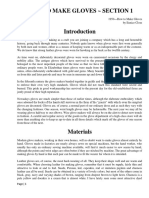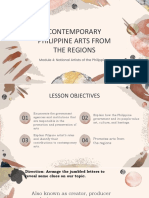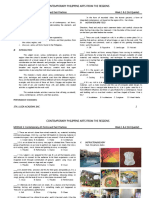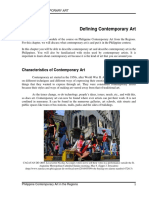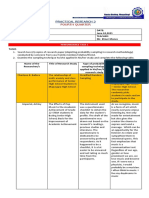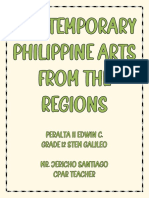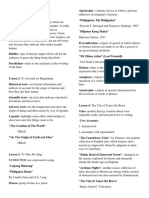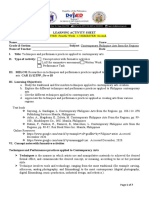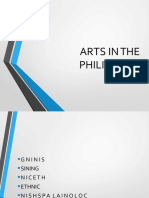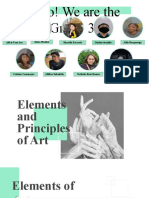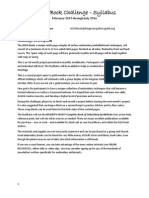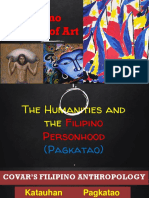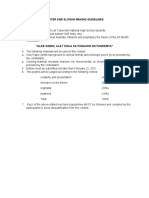0 ratings0% found this document useful (0 votes)
689 viewsContemporary Philippine Arts From The Regions
Contemporary Philippine Arts From The Regions
Uploaded by
Paulajean Almarez De CastroThe document discusses various aspects of contemporary art from the regions, including definitions, styles, subjects, elements and principles of design. It defines contemporary art as art produced in the present time using both traditional and new techniques. It explores several styles of art including realism, distortion, abstraction and non-objectivism. It also outlines key elements of art like space, line, shape, form, color, value and texture. Finally, it discusses principles of design such as harmony, variety, rhythm, proportion, balance, movement, emphasis and subordination.
Copyright:
© All Rights Reserved
Available Formats
Download as PPTX, PDF, TXT or read online from Scribd
Contemporary Philippine Arts From The Regions
Contemporary Philippine Arts From The Regions
Uploaded by
Paulajean Almarez De Castro0 ratings0% found this document useful (0 votes)
689 views26 pagesThe document discusses various aspects of contemporary art from the regions, including definitions, styles, subjects, elements and principles of design. It defines contemporary art as art produced in the present time using both traditional and new techniques. It explores several styles of art including realism, distortion, abstraction and non-objectivism. It also outlines key elements of art like space, line, shape, form, color, value and texture. Finally, it discusses principles of design such as harmony, variety, rhythm, proportion, balance, movement, emphasis and subordination.
Original Title
CAR (1).pptx
Copyright
© © All Rights Reserved
Available Formats
PPTX, PDF, TXT or read online from Scribd
Share this document
Did you find this document useful?
Is this content inappropriate?
The document discusses various aspects of contemporary art from the regions, including definitions, styles, subjects, elements and principles of design. It defines contemporary art as art produced in the present time using both traditional and new techniques. It explores several styles of art including realism, distortion, abstraction and non-objectivism. It also outlines key elements of art like space, line, shape, form, color, value and texture. Finally, it discusses principles of design such as harmony, variety, rhythm, proportion, balance, movement, emphasis and subordination.
Copyright:
© All Rights Reserved
Available Formats
Download as PPTX, PDF, TXT or read online from Scribd
Download as pptx, pdf, or txt
0 ratings0% found this document useful (0 votes)
689 views26 pagesContemporary Philippine Arts From The Regions
Contemporary Philippine Arts From The Regions
Uploaded by
Paulajean Almarez De CastroThe document discusses various aspects of contemporary art from the regions, including definitions, styles, subjects, elements and principles of design. It defines contemporary art as art produced in the present time using both traditional and new techniques. It explores several styles of art including realism, distortion, abstraction and non-objectivism. It also outlines key elements of art like space, line, shape, form, color, value and texture. Finally, it discusses principles of design such as harmony, variety, rhythm, proportion, balance, movement, emphasis and subordination.
Copyright:
© All Rights Reserved
Available Formats
Download as PPTX, PDF, TXT or read online from Scribd
Download as pptx, pdf, or txt
You are on page 1of 26
Contemporary
philippine arts from the regions
Contemporary arts
• Contemporary art is the art that springs out
of the present-day events and passions of the
society.
• It is the newest form of art, amusing people
from the middle to the late 20th century up to
this very period.
Contemporary arts
• Contemporary art is all the works that are
produced in our present time.
• These artworks can be expressed using the
traditional art forms such as paintings,
sculptures, etc. or can be produced using
new art techniques such as installation,
assemblage, etc.
THE SUBJECT OF ART
• To create your own contemporary piece, you
must fully understand what makes an
artwork a true work of art.
• You must explore the subject of art.
• Every work of art has a subject .
realism
• The first style is realism
in which the subject is
done the way it actually
looks.
• Bridal White by Araceli Dans.
2014. Watercolor on paper
distortion
• The second is distortion
wherein the artist uses
his or her imagination
and alters the subject
according to his or her
desire.
• Fiesta by Norma Belleza, 2012.
Oil on canvas
abstraction
• The third is abstraction
wherein the artist breaks
apart the subject and
rearranges it in a
different manner.
• Paintings of National Artist
Vicente Manansala
Non-objectivism
• The fourth is non
objectivism wherein there
is no totally subject at all
– just an interplay of pure
elements like line, shape,
or color and so on.
• Untitled No. 11 by Roberto
Charbet. 1980. Acrylic on
paper
THE elements OF ART
• Art forms in the different regions vary in
subject, theme, style, medium, and
technique.
space
• Space in visual arts can be defined as void,
an emptiness which can be either be positive
or negative.
• The positive space refers to a spaced
enclosed in as shape, while the negative
space denotes the opposite.
space
• In literature, it is the pause between words,
whereas in music, it is the interval between
notes.
line
• Line is the extension of a point, a short or long
mark drawn or carved on a surface.
– It is an implied path suggesting –Direction :
vertical, horizontal, diagonal
– Character : jagged, curved, series of dots and
broken lines
• In theater, a line may refer to the script of the
actor. In dance, it is the series of steps that a
dancer makes.
Shape \
• When the ends of a line meet, they form a
shape. Shape can also be described as a
figure separate from its surrounding are or
background.
• It can be either be geometric (angular) or
organic (curvy).
form
• Form is slightly similar to shape. It is an
enclosed line, a figure separate from its
background. But, remember that shape is
two-dimensional, while from is three-
dimensional.
color
• Color is a sensation created by visible
wavelengths of light caught in a prism. It is
mixture of organic or synthetic substances
called pigments, used as paint or dye.
• It creates a mood or tone, such as red for
passion, anger or love; blue for peace,
nobility, or sadness; and yellow for gaiety,
innocence or jealousy.
value
• In visual arts, value is the degree of lightness
or darkness of a color.
• In music, it is called pitch, which is the
highness or lowness of a tone.
texture
• Texture is the surface of an artwork. A texture
can be actual or tactile, meaning, it can really be
felt by touch; or it can be simulated or illusory,
which means it can only be seen, not felt.
• In music or writing, texture is the quality or style
of composition. The sounds from different
musical instruments allow one to hear texture in
sound.
Principles of design
• Design is the overall structure of an art form.
It is plan for order. It means by which artists
indicate and demonstrate the ideas and
feelings they wish to convey.
• The principles of design are also called the
organization of elements. They people make
sense of the environment, at the same time,
make it aesthetically pleasing and interesting.
harmony
• Harmony refers to the wholeness of the
design, the pleasing arrangement of parts,
and the agreement between parts of a
composition, resulting in a united whole.
variety
• Variety pertains to the assortment or diversity
of a work of art.
• We can see variety in all of our surroundings.
• Variations are produced so that monotony
and uniformity in the environment are
prevented.
rhythm
• Slightly contrary to variety is the rhythm or
beat. It is the regular, repeated pattern in the
elements of art. It is a flow, or feeling of
movement, achieved by the distribution of
visual units or sound units in time. The beat
can be regular or irregular, simple or
complex.
proportion
• Elements in a work of art should have a
relationship with one another, This
relationship is called proportion. A well-
proportioned shape is pleasing to the eye.
balance
• Balance pertains to the even distribution of
weight, It is the principle that deals with
equality. In art there are two types of
balance: - formal balance and informal
balance.
movement
• Movement is a fundamental principle in
choreography and the theater arts. It is away
to convey feelings and emotions. It is the
means by which dancers make use if their
bodies to express an inner condition. Actors
express their lines through facial expressions,
gestures, and body language as they move
on stage.
Emphasis and
subordination
• Emphasis is the principle that gives
importance or dominance to a unit or an
area. This is opposite to subordination, which
gives less importance to a unit or area.
You might also like
- How To Make Gloves by Eunice Close 1950-bDocument59 pagesHow To Make Gloves by Eunice Close 1950-blemezNo ratings yet
- Tattoo Machine SpringsDocument20 pagesTattoo Machine SpringsRichard Swan100% (3)
- Contemporary Arts: Lesson 1: Artistic Skills and TechniquesDocument4 pagesContemporary Arts: Lesson 1: Artistic Skills and TechniquesCloue Faye I. BasalloNo ratings yet
- English For Academic and Professional PurposesDocument10 pagesEnglish For Academic and Professional PurposesJoshua De los Santos100% (1)
- Wehrmacht UniformsDocument16 pagesWehrmacht UniformsErivaldo Júnior100% (2)
- CparDocument6 pagesCparI Don't KnowNo ratings yet
- Contemporary Module 15 and 16Document5 pagesContemporary Module 15 and 16Rodrick RamosNo ratings yet
- Essence of The Contemporary Arts of The PhilippinesDocument1 pageEssence of The Contemporary Arts of The PhilippinesAra LimNo ratings yet
- Senior High School Learning Module: Contemporary Philippine Arts From The RegionsDocument57 pagesSenior High School Learning Module: Contemporary Philippine Arts From The RegionsPantheia PenthesileaNo ratings yet
- 3rd Quarter Contemporary SUMMATIVE TESTDocument5 pages3rd Quarter Contemporary SUMMATIVE TESTCristel Anne A. LlamadorNo ratings yet
- Week 15Document16 pagesWeek 15Francine Mae HuyaNo ratings yet
- AJ AssignmentDocument8 pagesAJ AssignmentRamses Paul J. MalalayNo ratings yet
- Subject Matter and Style in Contemporary ArtDocument22 pagesSubject Matter and Style in Contemporary ArtKF RadaNo ratings yet
- Contemporary Philippine Arts From The Region: 3 Quarter 3Document12 pagesContemporary Philippine Arts From The Region: 3 Quarter 3BEBERLIE GALOSNo ratings yet
- Cpar Q1 Module 4 National Artists of The PhilippinesDocument71 pagesCpar Q1 Module 4 National Artists of The PhilippinesJane Marry Ignacio100% (1)
- Contemporary Philippine Arts in The Regions: Quarter 4 - Module 3Document22 pagesContemporary Philippine Arts in The Regions: Quarter 4 - Module 3Spade BunNo ratings yet
- Summative Test-CPAR (1st Quarter)Document2 pagesSummative Test-CPAR (1st Quarter)Cassidy ZapantaNo ratings yet
- Template For The Activity Week 5Document9 pagesTemplate For The Activity Week 5Sher-Anne Fernandez - BelmoroNo ratings yet
- Answer Sheet Con Arts Q1 Week 2Document4 pagesAnswer Sheet Con Arts Q1 Week 2Karla Joy Corpuz Marciano100% (2)
- Activity 1.3. My Own Color Wheel MartinezDocument1 pageActivity 1.3. My Own Color Wheel MartinezCalvin Moreno0% (1)
- CPAR Q2 Mod5Document14 pagesCPAR Q2 Mod5davidjugo558No ratings yet
- Week 2 2ND Quarter Understanding Culture, Society and PoliticsDocument1 pageWeek 2 2ND Quarter Understanding Culture, Society and PoliticsRachel Carongoy100% (2)
- Contemporary Philippine Arts From The RegionsDocument24 pagesContemporary Philippine Arts From The RegionsNina Romina Navalta50% (2)
- 2nd Quarter MODULE 4 On CONTEMPORARY PHILIPPINE ARTS From The REGIONSDocument16 pages2nd Quarter MODULE 4 On CONTEMPORARY PHILIPPINE ARTS From The REGIONSJerelyn ParohinogNo ratings yet
- CPAR WEEK 1&2 - Q3 2nd SemDocument12 pagesCPAR WEEK 1&2 - Q3 2nd SemGodofredo HermosuraNo ratings yet
- CC 109 - MLGCLDocument25 pagesCC 109 - MLGCLClark QuayNo ratings yet
- Pinoys Top Social Media Users, According To StudyDocument2 pagesPinoys Top Social Media Users, According To StudyLaiza MayNo ratings yet
- Contemporary Philippine Arts From The RegionsDocument25 pagesContemporary Philippine Arts From The RegionsJune Patricia AraizNo ratings yet
- Contempo Week 1-2 (Lesson 1&2)Document17 pagesContempo Week 1-2 (Lesson 1&2)Lumen AnnNo ratings yet
- Unit 2 Classification of Various Art Forms in The PhilippinesDocument13 pagesUnit 2 Classification of Various Art Forms in The PhilippinesSushi The NinthNo ratings yet
- CPAR Week 6Document8 pagesCPAR Week 6Marilyn Dizon100% (1)
- CPAR PPT 01 Integrative Arts As Applied To Contemporary ArtsDocument13 pagesCPAR PPT 01 Integrative Arts As Applied To Contemporary ArtsCedric Kurt TagubaNo ratings yet
- Skills Techniques and Production in Contemporary ArtDocument36 pagesSkills Techniques and Production in Contemporary ArtRoselyn Lictawa Dela CruzNo ratings yet
- Acquired Skills EnhancementsDocument3 pagesAcquired Skills EnhancementstinNo ratings yet
- Inter Text UalityDocument39 pagesInter Text UalityYhhhhhhhNo ratings yet
- Lesson 3 PDFDocument13 pagesLesson 3 PDFAlex Abonales DumandanNo ratings yet
- Cpar Lesson Plan 13Document4 pagesCpar Lesson Plan 13Malou LipataNo ratings yet
- CPH, Worksheet 19, Galon, Dindo, Jr. G.Document3 pagesCPH, Worksheet 19, Galon, Dindo, Jr. G.DJ GalonNo ratings yet
- Contemporary Philippine Arts From The RegionDocument2 pagesContemporary Philippine Arts From The Regionjeffrey rugnaoNo ratings yet
- Practical Research 2: Fourth QuarterDocument4 pagesPractical Research 2: Fourth Quartergamms upNo ratings yet
- ContempoDocument1 pageContempoAñana, Anessa JaneNo ratings yet
- Subject Matter and Style in Contemporary ArtDocument27 pagesSubject Matter and Style in Contemporary ArtKent Peter CuadradoNo ratings yet
- Mini Lecture and Activity Sheets in Contemporary Philippine Arts From The Regions Quarter 4, Week 5Document5 pagesMini Lecture and Activity Sheets in Contemporary Philippine Arts From The Regions Quarter 4, Week 5Darlene Dacanay David100% (1)
- CNF Finals LPDocument10 pagesCNF Finals LPJosh OfficialNo ratings yet
- Lesson 6 Introduction To Philippine Ethnic and FolkdancesDocument30 pagesLesson 6 Introduction To Philippine Ethnic and FolkdancesTristan PereyNo ratings yet
- Contemporary Philippine Arts Lesson 9-10Document6 pagesContemporary Philippine Arts Lesson 9-10Joey TaduranNo ratings yet
- Lesson 9 (Contemporary)Document22 pagesLesson 9 (Contemporary)Claren Opeña100% (2)
- Contemporary Art Forms in The PhilippinesDocument9 pagesContemporary Art Forms in The PhilippinesRafael AquinoNo ratings yet
- Florence B. Ajero - 12-Humss - Cpar Unit 1Document3 pagesFlorence B. Ajero - 12-Humss - Cpar Unit 1Florence Balino AjeroNo ratings yet
- Chapter 1 Lesson 1 - The Characteristics of Contemporary ArtDocument37 pagesChapter 1 Lesson 1 - The Characteristics of Contemporary ArtAngelika ValenciaNo ratings yet
- Peralta Cpar Week3Document7 pagesPeralta Cpar Week3Edwin Peralta IIINo ratings yet
- Subject: Cpar Week 3 Name: Edme Jay T. Lagradilla Year and Section: Abm-12Document6 pagesSubject: Cpar Week 3 Name: Edme Jay T. Lagradilla Year and Section: Abm-12Edme Jay LagradillaNo ratings yet
- THE Structure and Language of CritiqueDocument9 pagesTHE Structure and Language of CritiqueCedrick GenaveNo ratings yet
- Pe Test3 EssayDocument1 pagePe Test3 EssayAlvarez HazelNo ratings yet
- Math11 SP Q3 M7Document16 pagesMath11 SP Q3 M7Jessa Banawan EdulanNo ratings yet
- Contemporary Philippine Arts From The RegionsDocument24 pagesContemporary Philippine Arts From The RegionsOdessa L. UrgelNo ratings yet
- 21st Cent Lit ReviewerDocument2 pages21st Cent Lit ReviewerAshley Himson0% (3)
- Multiple Choice: Directions: Read and Answer The Questions Below. Select The Letter of The Best Answer From AmongDocument2 pagesMultiple Choice: Directions: Read and Answer The Questions Below. Select The Letter of The Best Answer From AmongBea allyssa CanapiNo ratings yet
- Ontemporary Hilippine Rts From The Egions: Module 7 & 8Document11 pagesOntemporary Hilippine Rts From The Egions: Module 7 & 8Einjhel Gaverielle ReyesNo ratings yet
- Cpar Las Melc 1 Q4Document7 pagesCpar Las Melc 1 Q4Angela Izavelle RafananNo ratings yet
- Cpar Arts in The Philippines..1 1Document56 pagesCpar Arts in The Philippines..1 1Liam BaxtonNo ratings yet
- Arts Appreciation Group 3Document174 pagesArts Appreciation Group 3Abbie Faye E. LeeNo ratings yet
- ArtApre Week 8Document62 pagesArtApre Week 8tomoko kurokiNo ratings yet
- Freddy Chauke A2Document1 pageFreddy Chauke A2anzaniNo ratings yet
- Stitch Book Challenge Syllabus Materials ResourcesDocument3 pagesStitch Book Challenge Syllabus Materials Resourcesapi-232891273100% (1)
- Playing With PoverDocument13 pagesPlaying With PoveremiliosasofNo ratings yet
- RomanticismDocument3 pagesRomanticismBrianNo ratings yet
- Photography Monthly - June 2011Document124 pagesPhotography Monthly - June 2011Paul JohnNo ratings yet
- Egger Perfectsense tm9Document4 pagesEgger Perfectsense tm9hoban teodorNo ratings yet
- Painting Dark ElvesDocument2 pagesPainting Dark ElvesjpNo ratings yet
- Ar-100 - Drawing Register, SpecificationsDocument1 pageAr-100 - Drawing Register, SpecificationsSamy JainNo ratings yet
- NUFORM Wall Finishing GuideDocument20 pagesNUFORM Wall Finishing GuidemartadijayaNo ratings yet
- Art, Nature and Encounters - Arjay CostorioDocument2 pagesArt, Nature and Encounters - Arjay CostorioArjay AbibinerNo ratings yet
- 1khornak L Fashion PhotographyDocument150 pages1khornak L Fashion PhotographyAlvaro Pouey100% (1)
- The Touch of NatureDocument8 pagesThe Touch of NatureAmrita RoyNo ratings yet
- Unit 1. Colors PDFDocument42 pagesUnit 1. Colors PDFPaola LÓPEZ PEÑASNo ratings yet
- WorldScen1990 2005 Sample PDFDocument46 pagesWorldScen1990 2005 Sample PDFPaulGabrielVillaseñorEstrada50% (2)
- Delhi Crafts MuseumDocument4 pagesDelhi Crafts MuseumChania Bhatia100% (1)
- Mills & Boon Cherish Chapter SamplerDocument19 pagesMills & Boon Cherish Chapter SamplerMills & Boon Australia100% (1)
- Art Appreciation - The Filipino Concept of ArtDocument25 pagesArt Appreciation - The Filipino Concept of ArtRex GonzalesNo ratings yet
- Odermatt and TissiDocument5 pagesOdermatt and TissiInge EconomouNo ratings yet
- EA Revolving DoorDocument4 pagesEA Revolving DoorzitreeNo ratings yet
- On Classification of Possible Colourblind Pictorial Painters Dichromatic TypeDocument18 pagesOn Classification of Possible Colourblind Pictorial Painters Dichromatic TypePer BangNo ratings yet
- Nikon FM2 INSTRUCTION MANUALDocument50 pagesNikon FM2 INSTRUCTION MANUALNghĩa ZerNo ratings yet
- Poster and Slogan Making GuidelinesDocument2 pagesPoster and Slogan Making GuidelinesTeacher NhorNo ratings yet
- Hardcore Aerosol Spray Paint GRAFFITI MONTANA COLORSDocument1 pageHardcore Aerosol Spray Paint GRAFFITI MONTANA COLORSKaila PrescottNo ratings yet
- El Paso Scene February 2010Document60 pagesEl Paso Scene February 2010Anonymous gMmJrV1pfNo ratings yet
- Composite Tank FinalDocument30 pagesComposite Tank FinalAmru AmruteshNo ratings yet
- Passerine - Chapter 1 - Blujamas, Thcscus (Blujamas) - Video Blogging RPF (Archive of Our Own)Document1 pagePasserine - Chapter 1 - Blujamas, Thcscus (Blujamas) - Video Blogging RPF (Archive of Our Own)kingamelie7No ratings yet
- Bloomsbury Photographs 239-241Document218 pagesBloomsbury Photographs 239-241Norka Korda100% (2)
